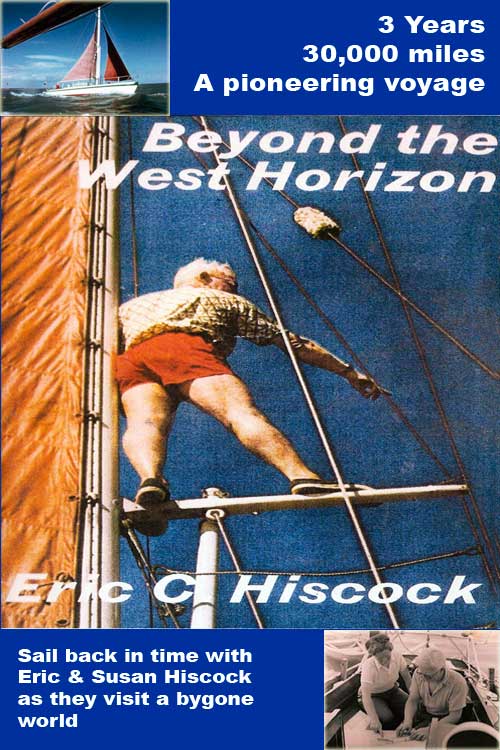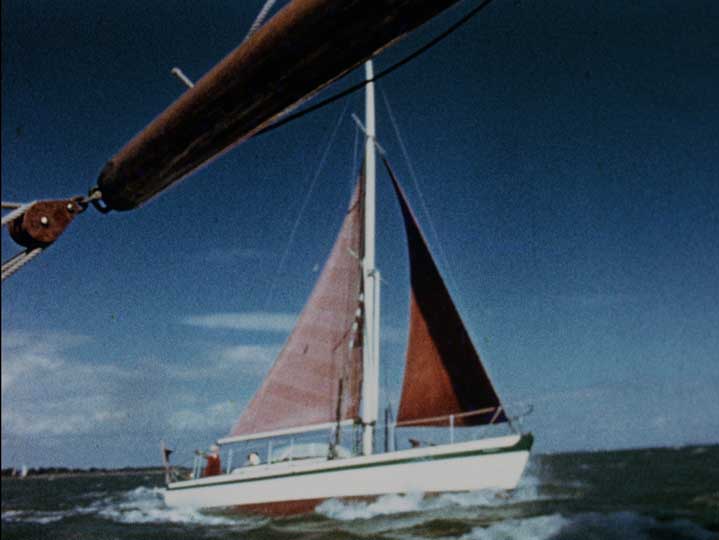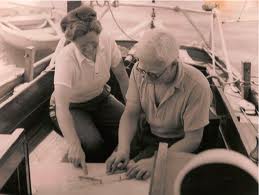The Proper Wanderers
[Text from Don Holm’s ‘The Circumnavigators’ , ch. 18]

“Yesterday afternoon, Mr. and Mrs. Eric Hiscock left Yarmouth, Isle of Wight, on the first stage of a voyage round the world in their 30- foot yacht Wanderer III. The voyage is expected to take three years .”(1)”
To LIVE ON THE ISLE OF WIGHT AND NOT TO BE A FARMER or make one’s living from the sea is unthinkable. It is even more unthinkable to live on Wight and not own or sail a yacht. This oyster-shaped island lies just off Southampton Water, separated from the mainland by the famous yachting grounds, the Solent, and provides a buffer between the mainland harbors and the English Chan- nel. Directly south and about sixty miles away is Cherbourg and the Normandy peninsula. About the same distance to the east is the prime meridian of Greenwich, which separates the globe into east and west longitude. From here, it is said, you are already halfway to anywhere.
At Cowes, on the inner side, on the Medina River, is one of the most famous yachting centers in the world, and the home of the Royal Yacht Squadron, and the scene of the historic race in 1851 between the America and 14 British vessels around the Isle of Wight for the 100-guinea prize now known as America’s Cup.(2) On the western tip lies Yarmouth, at the mouth of the narrow inlet.
Eric and Susan Hiscock lived on the island at Yarmouth, and like everyone else were close to the sea. Eric’s first boat was an 18-foot sloop, built in the 1890s and named Wanderer. She was lean of bow and fat in the haunches and was a bitch to sail in any kind of a breeze. But she was all Eric could afford when he bought her for $125, and before he got rid of her for another, she very nearly drowned him.
The internationally famous Jack Laurent Giles was just getting started as a yacht designer when Eric approached him to build Wanderer II. Giles had under construction then the first of his famous Vertue line of fast, seaworthy 25-footers which have since sailed all the oceans of the world in safety. Hiscock could not afford a boat this big, so Giles reduced the model to fit his pocketbook. The result was a fast and handy little sloop of 21-foot waterline and 7-foot beam. In her, Hiscock cruised extensively in channel and European waters. Then, when he and Susan were married, they made a honeymoon cruise to the Azores and back along the coast of Spain and France. Wanderer II, even though it did not have an engine, was a proper yacht, and gave the couple some of their most nostalgic sailing experiences. It also taught them to be expert sailors under all conditions.
As is usually the case, the Azores voyage did not satisfy their craving for wandering it only stimulated it. Now they wanted to see more of the world, but in a larger yacht so they could carry more stores and water. So they went back to Jack Giles and he drew up Wanderer III, an enlarged Vertue, 30 feet overall, with a waterline of 26 feet 6 inches and a beam of 8 feet 6 inches. Like all Giles boats, she was narrow, but not tender as was Wanderer II. She was built of iroko and steambent oak frames, copper-sheathed and rigged as a Bermudian sloop instead of a gaff cutter. She also had a 4-horsepower engine, and a fuel capacity of 50 miles.(3)
For the next 17 years, Wanderer III roamed the oceans of the world, the Hiscocks becoming the first couple to make two circumnavigations. Early in his sailing career, Hiscock had begun to write accounts of his cruises for the yachting magazines, illustrating them with his own photographs. The honeymoon cruise to the Azores provided material that helped pay for the trip. On the first circum- navigation, the Hiscocks also helped defray expenses with articles and photography. Wanderer III, and later Wanderer IV, was equipped with a darkroom. The several books that resulted from these voyages became best-sellers among yachting and cruising folk.(4) The income from these, plus fees for lectures upon their return to England, prompted them to sell their home and cut their ties permanently with land-living. On the second circumnavigation, they filmed the voyage for a television documentary, which earned them enough to build Wanderer IV, a large and commodious 49-foot steel ketch.(5)
At the time they began their first circumnavigation, the Hiscocks were only allowed to take £25 of foreign currency a year out of England, so it was necessary to stock up as much as possible before leaving. Wanderer III was launched one lovely spring day in 1952, with Susan breaking the bottle of wine over her bows. Shakedown cruises were made from Yarmouth, and around Ireland, seeking out the worst weather and sea conditions to test the new vessel. Then the fitting out began. When all the books, photographic supplies, canned foods, and materials for a year were aboard, Wanderer III rode six inches lower in the water than Jack Giles had designed her.
Departure was made from Yarmouth on July 24, 1952, and after a lumpy voyage that included stops in many out-of-the-way places in France, Spain, and Portugal, they arrived on October 2 at La Palma, a distance sailed of 1,857 miles. At Cascais, near Lisbon, they mingled for the first time with that elite society of yachting people, the ocean vagabonds and their little ship-homes. Waiting at Cascais for the proper season were Peter and Anne Pye in Moonraker, and the Dutch yacht Harry, both bound for British Columbia on the North- west coast of America, and the Viking, with the charming Swedish couple, Sten and Brita Holmdahl, who like the Hiscocks were embarked on their first circumnavigation, and who would be encountered frequently in exotic places during the next few years.
At Cascais, too, the Hiscocks got their first taste of official arrogance and harassment by police, which came as a shock to these gentle people.
From Cascais to Madeira, they enjoyed a near-perfect sail-long days of bright sun in a clear blue sky, at night a sky brilliant with stars and a wake full of blazing phosphorescence. It was almost lyrical.
In Madeira, they caught up on their writing and photography, maintenance on the boat, and enjoyed the local yachting society. On October 11, they departed for their first long ocean passage, to the West Indies, timed to avoid the hurricane season. The voyage took twenty-five days, and for the most part was a delightful cruise in spite of the heat and the often violent rolling under twin headsails. In the cool of evening, they would spend their twilight hour together in the cockpit over a drink, talking of many things, watching for that elusive moment when the sun suddenly goes down in the west with a green flash, then the first view of Venus between the luffs of the twins while Mars rose astern, and everything in the world was at peace.
The only thing to disturb this tranquillity, Hiscock observed wryly, was the motion of a narrow boat running under twins in a seaway. The human body can adjust to almost any inconvenience or discomfort but this.
They cruised among the West Indies until December 28, when they sailed from Antigua to Cristobal, Panama. On January 15, they made their first canal transit. Their first encounter with American officialdom was pleasant. The brisk and efficient officer filling out the form asked Hiscock’s age. It was forty-four, he answered. The official then wrote down thirty-nine for Mrs. Hiscock. “How did you know?” Eric asked. “Well,” said the official, “no dame is over thirty-nine.”
The passage through the notorious locks cost them $3.75, including the services of the pilot. But even with the help of Sten and Brita Holmdahl, the transit was somewhat of an ordeal. Once in the Pacific, they tied up at the Balboa Yacht Club, and joined the crowd of sea wanderers that included Buzz and June Champion on their Hanna ketch, Little Bear. With the help of new American friends, they spent a busy ten days making preparations, and were invited to a “brawl” at the American Legion Club, where, to get in, they had to climb a ladder and slide down a wooden chute.
They had intended to visit the Galapagos for water and fresh provisions, but Ecuadorean red tape and the large fees demanded changed their minds. They confided to a friendly canal pilot that they might stop there anyway, but the pilot warned them not to do so as many fishing vessels and yachts had been seized even on minor technicalities. The Hiscocks then decided to go directly to the Mar- quesas, 4,000 miles down the trades and the longest passage of their career. Leaving January 26, they arrived at Nuku Hiva on March 4 in a flawless passage.
At 10:30 P.M. on the thirty-sixth day at sea, when they saw Ua Huka rising under a new moon, they thrilled at their introduction at last to the enchanted South Pacific islands. The track up to this point was fairly standard for voyagers. From here on, they went directly to Tahiti, and after a long stay in the Society Islands, sailed to Pago Pago, then to Fiji, cruising among these islands for a month or more, and then went on to spend the winter (summer there) cruising the delightful waters of New Zealand.
On January 12, they crossed from Whangaroa to Sydney, where they spent several months. On June 9, they departed up the coast of Queensland inside the Barrier Reef, went through Torres Strait, and continued on to Thursday Island.
They crossed their third ocean, the Indian, without the usual gales. Christmas Island came up on July 4. From here, following Slocum’s classic route, they made Keeling-Cocos on July 17. After a month here, they sailed on to Rodriguez, arriving September 7. After a short stay, they went on to Mauritius, where they waited until October 2 before departing for Durban. They rounded the bight of South Africa from December 31 to January 17, with a stop at Port Elizabeth. Three months were spent in Cape Town. On March 15, they sailed for Robben Island, and then on to St. Helena and Ascension. From Ascension, they made their longest passage, fifty-one days and eleven hours, to Horta, Azores. On June 22, they departed Horta, and arrived off England on July 6. From July 10 to 13, they sailed around to Yarmouth and home.
The short passage from Horta to the Lizard, only 1,200 miles, would normally be no problem for these new world travelers, except that now they experienced their first taste of “channel fever.” Anxious to get home, they were becalmed off St. Mawes. Finally, they made an anchorage where customs cleared them and old friends welcomed them to home waters. After a short rest, they started around to the Isle of Wight, passing the familiar landmarks of Start, Portland, Anvil, and the Needles, and then Wanderer III now a true and tested sea wanderer, her brown sails faded by tropical suns, her ropes bleached white by the spray of three oceans, and flying the ensigns of all the countries she had visited from the starboard yard slipped quietly into Yarmouth harbor, concluding a delightful 32,000-mile circumnavigation.
The next voyage of Wanderer III was by truck at Christmas, 1955, to the Second National Boat Show at Olympia, at the request of the designers and builders, and in collaboration with the Beaverbrook newspapers, for an exhibition of British boat-building skill.
There, for ten days, Eric and Susan, with the gentleness, patience, and good feeling they have for their fellow man, stood eleven hours a day as the crowds filed by to have a look at this famous little ship and talk to the owners. They answered each question, no matter how silly, for they understood how it is with people who have secret dreams….
In order to escape from the pressures of lectures and writing assignments, and from their new notoriety, the Hiscocks sailed once more in July 1959 for their second circumnavigation, going east-about via Panama and the Suez Canal. In 1965, they crossed the Atlantic and cruised around the United States for a couple of years.
Now, with royalties coming in steadily, lecture offers plentiful, and a new source of income from television to say nothing of worldwide prestige and a Blue Water Medal from the Cruising Club of America they felt that they had outgrown their faithful Wanderer III. They sold her reluctantly and acquired Wanderer IV, designed by S. M. Van der Meer and built of steel in Holland in 1968. She was 49 feet overall, ketch-rigged, and had a 61-horsepower Ford diesel. She was first exhibited in an English boat show, then sailed to the West Coast of North America via the West Indies and Panama.(6) From there, the Hiscocks sailed to New Zealand to cruise those delightful waters at their leisure. At this writing, they were still there, living aboard Wanderer IV, which they found too large for them, a bit of a maintenance problem, and a sluggish sailor under light winds, in spite of all her modern conveniences and appointments. Much of this, no doubt, was pure nostalgia for their home of seventeen years, the handy little Wanderer III.
The Hiscocks did not go to sea to experience hair-raising adventures. All of their voyages were carefully planned and flawlessly executed, with few surprises, and in the proper way for a middle-aged British couple seeking only personal tranquillity and the freedom of long ocean passages. In their quiet and competent way, without the fanfare of a Chichester or a Blyth, they came to epitomize, perhaps more than any yachtsmen in British history, the proper seagoing citizen.
AUTHOR’s NOTES
1. From a BBC newscast, quoted in Around the World in Wanderer III by Eric C. Hiscock (New York and London: Oxford University Press, 1956).
2. The America was designed by George Steers after the fast pilot schooners of the time for a syndicate headed by John Cox Stevens, founder of the New York Yacht Club. The America was finished in June 1851 and sailed across the Atlantic for the race around Wight She easily defeated the fourteen other vessels in the Royal Yacht Squadron Race. In 1857, the owners deeded the Cup to the New York Yacht Club with the condition that it be forever placed in international competition, open to any foreign yacht club with a vessel of thirty to three hundred tons. Over the years, English, Scottish, Canadian, Irish and Australian yachts have tried to win it, but as of this writing, the Auld Mug remains at the NYYC.
3. The Hiscocks, who thought Wanderer II too small, were taken aback when the new owner, “Tahiti Bill” Howell, and another Australian, Frank McNulty, sailed her from the United Kingdom to the Society Islands in good time with no difficulty; and when Bill later sailed her alone to Hawaii and then to Seattle, where he sold her. The Hiscocks met up with Wanderer II later in Hawaii, where they found her in good condition, but mounting a large outboard motor on the transom.
5. Erstwhile voyagers who dream of financing their ships with freelance writing should take note that the Hiscocks were the only couple in yachting history to do so successfully. They succeeded, not only because of proper timing at the proper point in history, but because they were industrious, level headed, thrifty, and simple-living to an extreme seldom found in dreamers. They were also good business people, and started with a sound financial footing. It also helped to be able and articulate writers, and competent photographers. Even if one could sell regularly to the yachting publications and Sunday supplements in the face of the competition, the rates paid are so low that no one could finance a voyage outside the harbor from this source alone, especially at today’s costs. The most successful sea wanderers have some sort of profession or trade that is in demand wherever they go, such as that of machinist, welder, doctor, dentist, cabinetmaker, rigger, with which temporary employment can be obtained. Today, the ports of the world frown darkly on penniless wanderers. Incidentally, the Hiscocks purchased Wanderer III for only £3,300 in 1950. Their annual expenses on the first circumnavigation amounted to about £700 a year.
6. Without doubt, the Hiscocks obtained Wanderer IV at considerable discount in return for the subsequent worldwide publicity and implied endorsement, which is one of the fringe benefits of becoming rich and famous.



Reviews
There are no reviews yet.